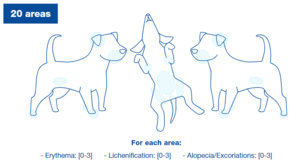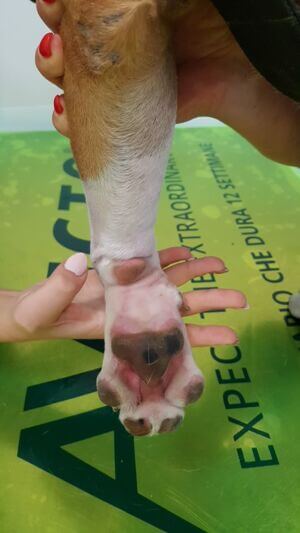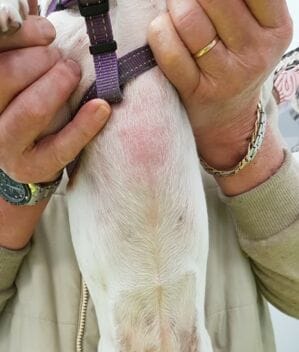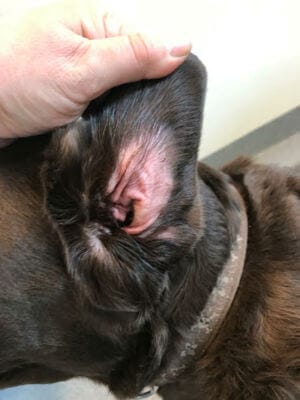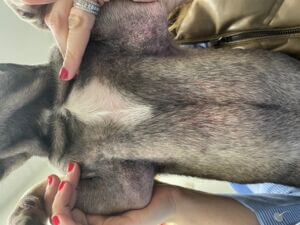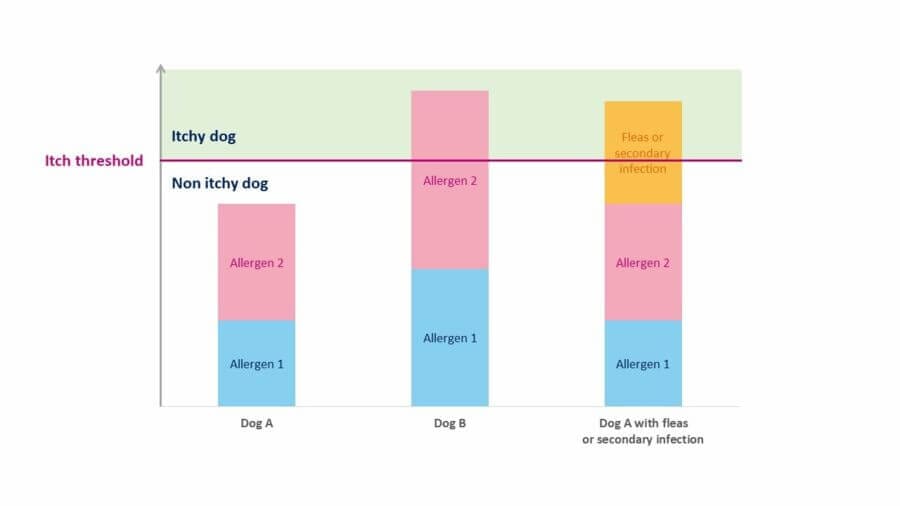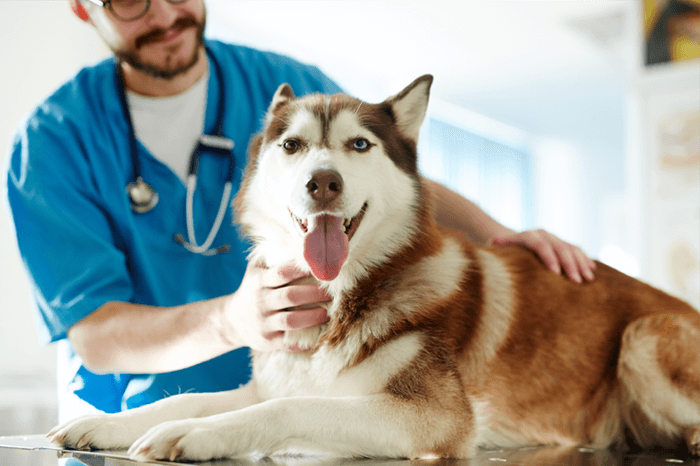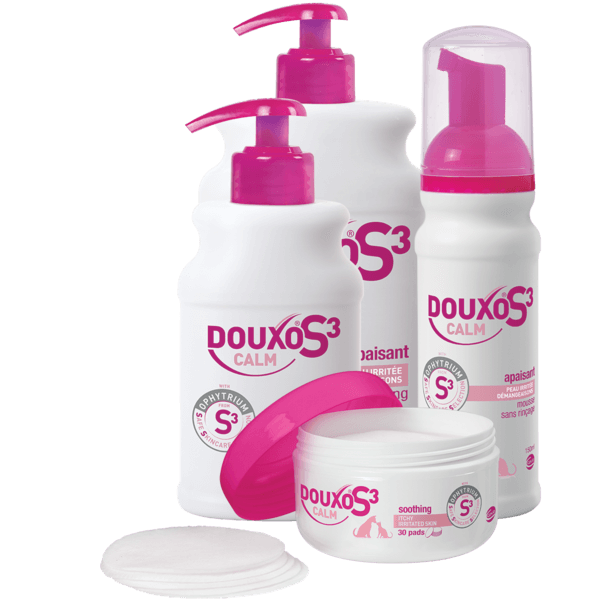All you need to know about atopic dermatitis in dogs
Marina G VeterinarianAllergies to environmental offenders such as mites, moulds, pollens are common, affecting around 10 to 15% of dogs. This lifelong disease can affect their quality of life, so recognising it and manage it are essential.
Atopic dermatitis, is an allergic skin disease in dogs to allergens present in the environment. Similar to eczema in people, it is a common problem, with 10-15% of dogs affected. Atopic dermatitis is a lifelong condition that needs to be well managed, otherwise it can cause misery for dogs and their owners with the constant irritation of itchy skin and both often being kept awake throughout the night by the constant scratching.
What are the signs of atopic dermatitis in dogs?
Atopic dermatitis causes a wide range of symptoms. In most cases, first signs occur between 6 months and 3 years. Some dogs have such mild signs that the owners may not be aware their dog has an allergy. However, it can cause constant and severe itching in severely affected dogs and results in self-trauma and severe skin damage. Quite often (although not always), the pattern of skin inflammation will give your vet a clue that your pet has an allergy. Commonly seen symptoms of atopic dermatitis in dogs include:
- Itchy skin (pruritis)
- Scratching or excessive licking/biting at an area of the body (with licking, you may see telltale reddish-brown signs – this is saliva staining) or rubbing
- Red, inflamed skin
- Hair loss
- Otitis externa (ear inflammation that can evolve to infection)
Longer term, if left untreated skin changes can become apparent, with the skin becoming thickened and darker in colour. Classically affected parts of the body include the face, ears, chin, armpits, belly, groin and the feet – and in particular, between the toes.
What types of things trigger atopic dermatitis in dogs?
All known allergens that cause atopic dermatitis in dogs are organic. That means they are of natural origin. The chemicals found in household cleaners do not cause atopic skin disease even they can cause skin reaction.
The real culprits are organic, microscopic and everywhere. Common allergens include:
- Pollens from trees, grasses and weeds – being seasonal, this may be the reason you notice your dog becomes itchier at certain times of the year
- House dust mites and storage mites ; in this case, itch is not seasonal
- Moulds
- Human dander
Dogs can be allergic to several things, and sometimes, presence of only one allergen is not enough to trigger an itch flare-up. Presence of additional factors / allergens can be necessary to reach the ‘itch threshold’ and to tip them over into having a noticeable skin problem. Every dog will have their own individual itch threshold – the point where all of the sources of itching get to a point to cause the dog to want to scratch. These dogs present with defect of the skin barrier. The weakened skin barrier of atopic dogs means normal skin bacteria and yeasts (called “Malassezia”) can get in and cause or enhance the inflammatory response. The presence of skin parasites, such as fleas can also worsen atopic dermatitis. This is known as the “summation of effects”. Think of it as all these factors together turning the volume up on the itchiness of the skin.
Are certain breeds more affected by atopic dermatitis ?
With such a strong association with certain breeds, it has long been suspected that there is a genetic link to atopic dermatitis. It is thought that particular genetic makeups result in a weakened skin barrier, making it easier for the triggering substance, such as pollen (known as an “allergen”), to cross the skin. Those breeds predisposed to atopic dermatitis include notably West Highland White Terriers, Golden Retrievers, Labrador Retrievers, Shar Peis, Dalmatians, Boxers, Boston Terriers, Bulldogs (English and French), Bull Terriers, Pugs, German Shepherds, and Bichon Frise.
How is atopic dermatitis diagnosed?
Diagnosing a dog with allergies is quite easy based on clinical signs, however, establishing the cause of the allergy is more difficult. Atopic dermatitis is a diagnosis made by exclusion. This means that your vet must first run tests to rule out other common skin diseases which can cause similar signs.
Treat secondary bacterial or yeast skin infections
If your dog has a secondary infection as a result of skin trauma (scratching, biting etc.) your vet will need to treat this first and foremost.
Rule out parasites
Your vet will check for parasites such as fleas (which can cause flea allergy dermatitis – also known as FAD – in dogs which are hypersensitive to flea saliva) and mites.
Explore the possibility of food allergies
It’s possible your dog could be allergic to an ingredient in their food. If this is suspected, your vet will recommend a food trial in which a specific diet is fed for at least 8 weeks. If your dog improves on this diet but then starts to show symptoms again once potential allergens are added back in (one by one), you can be confident that your dog has a food allergy.
Final step ; identify the allergens causing atopic dermatitis
Once your vet has ruled out all other possible causes of skin disease, and they remain confident that your pet is atopic, then they may recommend the diagnosis is confirmed with a test for atopic dermatitis. There are two commonly used tests for atopic dermatitis. Intradermal testing involves injecting a small amount of possible antigen into the skin (i.e. pollen) and seeing if there is a reaction (small, painless hives that rapidly resolve). Then there is a blood test, Allergen Specific IgE Serology (IgE is a specific sort of antibodies), which checks for elevated IgE levels against common antigens. Both can lack accuracy, and this is why all other possible causes must be excluded first before doing these tests.
What is the treatment for atopic dermatitis in dogs?
There is currently no cure for atopic dermatitis, so treatment aims to relieve itchy, sore skin or make the body tolerate the allergens. Mutiple approaches to treatment are often needed and this will continue to evolve throughout the dog’s life. Treatment of atopic dermatitis broadly falls into the following categories; treatment of co-existing skin problems, treatment to improve the quality of the skin barrier, reducing exposure to the allergen and suppression of the abnormal inflammatory response.
Avoidance of triggers
If you have found your dog’s specific allergen, avoid it as much as possible. The difficulty here is that allergens are typically very difficult to avoid or remove from the environment. With seasonal allergens, such as pollens, there is hope that there will be some relief for your pet at least part of the year. Non-seasonal allergens, which are common causes of atopic dermatitis in dogs, such as house dust mites, can be very difficult to remove from the environment.
Removing carpets, regularly vacuuming and dusting, and regular cleaning of bedding, may help to reduce symptoms with house dust mites.
You can also avoid walking your dog when the pollen count is high, and avoiding walking in long grass is key. Washing or wiping them down after a walk can also help.
And see if turning down the volume a bit, rather than aiming for a complete clinical cure, can achieve a good quality of life for your pet on the lowest possible level of medication.
All atopic dogs should be on strict monthly treatment against skin parasites, particularly fleas.
Dietary management may also help with an underlying food allergy in addition to atopic dermatitis; Once the food allergen is identified, the solution is to find a food not containing it. This should always be done under strict veterinary supervision.
Treat secondary skin infections
Most skin infections are caused by bacteria and yeast that live naturally on the skin surface, and there is often an overgrowth of these bugs on atopic skin. If you notice signs of a secondary infection in your dog, make an appointment with your vet. A bacterial skin infection may be often managed with topical products. Yeast, such a Malassezia can be controlled with topical products as well. Use during several weeks of antiseptic topical products such as DOUXO® S3 PYO Shampoo, Mousse and/or Pads containing chlorhexidine 3% reduce their numbers and the inflammation they cause without drying out skin while soothing the skin and strengthening the damaged skin barrier.
Apply topical products regularly to improve the skin barrier, soothe the skin and equilibrate the microbiota
In cases of atopic dermatitis, the dog’s skin barrier becomes damaged and will need support to repair. Topical products are a key part of this, applied directly to itchy, sensitive, irritated skin with a very low risk of side effects. Some products, such as the DOUXO® S3 CALM line, can work to restore the three skin barriers (mechanical, microbiological and immunological).
An effective plan for the use of such topical products is using a combination of shampoos and mousses. The shampoo is used first to cleanse the skin and fur, removing dirt, debris, dead skin and allergens. But of course, these are rinsed off and so the ingredients only have a set amount of contact time with the skin. To combat this, mousses can be used which are not rinsed off, allowing the ingredients to remain on the skin for longer. In addition to this, for small, localised irritations, products such as DOUXO® S3 CALM Pads are perfect to use.
Reducing the inflammatory response and itch with drugs
If you can’t eliminate the trigger allergens, it may be necessary to suppress the abnormal inflammatory response and itch with medications prescribed by your veterinarian such as glucocorticoids (steroids). They are handy for short term use in the treatment of flare-ups. Giving the treatment as a spray rather than tablets, helps some patients avoid the side effects.
Some medications may be given that modify the response of the immune system (known as immunomodulatory) and some may be given to focus mainly on relieving the itch. Anti-histamines may also be considered, but doesn’t work as well alone in dogs as it does in humans. Your vet will formulate a medication plan most appropriate for your dog.
Treating the cause
Allergen-specific immunotherapy, or desensitisation therapy, is a treatment where dogs are given a diluted version of the allergen as a type of vaccine. The dog gets used to the allergen, and reactions become less severe. This treatment will improve your dog’s skin in about 50-80% of dogs (improving completely the skin, or reducing the use of medications), results depending also on the allergens. You vet will advise you on the interest of such treatment. On top of that, it takes up to 12 months of monthly injections to know if desensitisation has worked.
We recommend
Our solution for itchy, irritated and sensitive skins.
DOUXO® S3 CALM soothes itchy, irritated and sensitive skin while balancing skin microbiota which is commonly unbalanced in sensitive skins. It helps to protect the skin barrier ecosystem from allergens and improves skin hydration.

